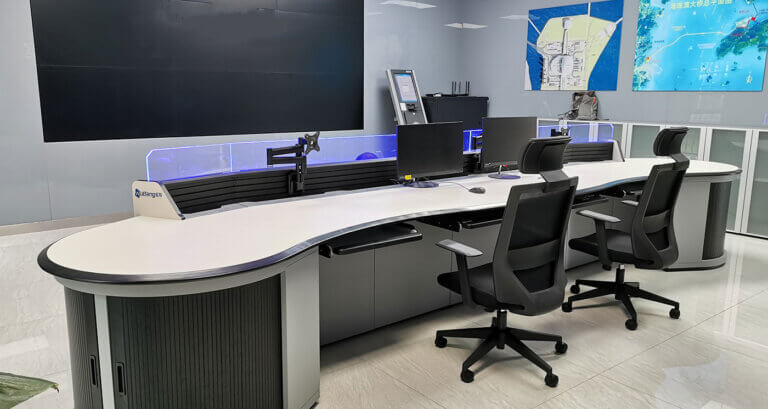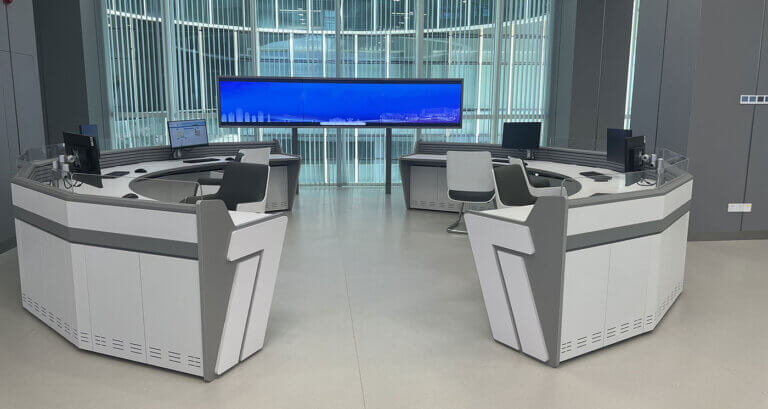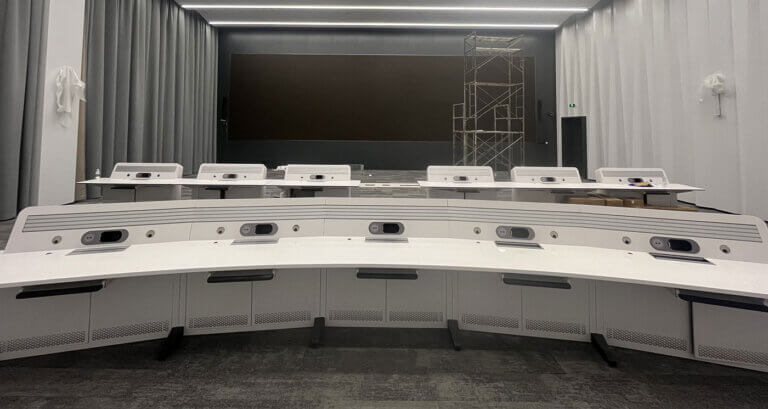
Product Categories

Hong Kong-Zhuhai-Macao Bridge Police Station

World Meteorological Center Hong Kong-Zhuhai-Macao Branch Center

Shanghai Hongqiao Airport Command Center
A process control room is a centralized location where plant managers, engineers, and operators oversee critical industrial processes. Inside the control room, teams monitor complex systems — often in real-time — using computer terminals, video walls, HMIs, and other visualization technologies.
For example, operators might track variables like:
When metrics fall outside target ranges, control room staff can spot issues instantly and take corrective actions if needed. Without effective process monitoring and quick incident response, industrial plants would experience more safety issues, production disruptions, and product defects.
Simply put: process control rooms enable organizations to maximize performance, efficiency, compliance, and safety of complex industrial systems.
Within any large facility in sectors like utilities, oil and gas, transportation, and manufacturing, there are many critical systems that must be actively monitored and managed. Without a centralized hub for process control, it would be impossible to coordinate these complex systems and ensure efficient, continuous operations.
A process control room serves as this essential hub. In a nutshell, process control rooms perform the following key functions:
In summary, a process control room is essential for efficient monitoring, coordination, emergency action, and optimization. Without it, vital infrastructure and services we all rely on would grind to a halt.
While smaller sites may only have a few operators on staff, larger industrial complexes have sizable teams overseeing activities around the clock.
But broadly speaking, process control room staff fit into a few key groups:
Plant/operations managers – Oversee control room teams and complex plant processes to maximize uptime, output, compliance, and profit margins. They coordinate escalation protocols during critical events.
Control room supervisors – Seasoned technicians that oversee a shift of operators. Supervisors provide guidance to resolve technical issues and make judgement calls when abnormal situations arise.
Process control engineers – Monitor control room dashboards for abnormalities, fine-tune processes for efficiency, manage control room infrastructure, and ensure optimal integrations between related systems. Their deep domain expertise provides technical guidance when troubleshooting complex issues.
Control room operators – Monitor system dashboards, trends, and alarms during shifts. They identify anomalies, trigger emergency responses per protocols when critical events occur, and keep detailed shift logs. Operators must quickly differentiate between routine fluctuations and urgent matters to escalate.
While their focus areas differ, the teams collaborate seamlessly to keep operations humming.
While they can vary significantly in size and exact equipment from one facility to another, process control rooms are typically packed from floor to ceiling with screens, servers, workstations, and highly customized furniture and infrastructure. Some typical process control room components include:
Though the specific equipment present does vary between industries, virtually all process control rooms share common design elements like video walls, operator workstations, serve rooms, and redundant power infrastructure.
Far too often, organizations invest heavily in control room tech without giving enough forethought to the most practical spatial design, layout or ergonomics. But space planning mistakes diminish the effectiveness of even the most sophisticated solutions.
Here are a few key design factors to get right from the start:
Centralized line of sight – The room layout should enable easy viewing of all monitors from any spot. Operators must avoid excessive head movements when cross-referencing multiple displays during high-intensity situations.
Ample operating space – Even compact control rooms must allow fluid movement during shift changes or peak collaboration events between multiple technicians.
Acoustic design – Echo reduction materials on walls absorb sound for improved communication clarity. Noise from HVAC equipment also needs isolation.
Lighting zones – Separate task lighting zones prevent glare on screens while still providing ample room brightness for safe operator movement.
Redundant power protection – Backup power systems sustain all mission-critical equipment availability during grid outages to avoid visibility loss.
Accessibility – Avoid potential physical obstructions from cable conduits or miscellaneous equipment impeding high-traffic paths. Such barriers slow operator response times.
Structured workflows – Logical desk groupings by function, workflow or process area ease collaboration for related processes. Keep teams integrated by sightlines.
While often treated as an afterthought, meticulous control room space planning sets the stage for teams to effectively leverage the specialty technologies on the floor every hour of operations across shifts.
For any business in a vital sector like manufacturing, transportation, utilities, emergency services, and more, having continuous visibility and centralized control over all assets and systems is critical. Without this oversight, issues could go unnoticed for too long, leading to:
All of this translates into major financial losses. But even more importantly, gaps in process monitoring can even put lives at risk if hazards spread or key services like power or emergency dispatch experience disruptions.
Some key reasons process control rooms are indispensable include:
Cost Savings – By enabling real-time optimization, emergency event mitigation, predictive maintenance, and more, PCRs generate major cost savings and support profitability across operations. Studies have shown returns on investment in process control technologies topping 200%.
Regulatory Adherence – Within highly regulated sectors like energy and manufacturing, process control room data provides the necessary documentation to prove adherence with safety, sustainability reporting, outage prevention standards, and more. This avoids major fines.
Safety – Potential equipment failures, leaks, pressure build ups, weather threats, unauthorized access, and more are often rapidly identified and resolved before impacting personnel or surrounding communities thanks to vigilant PCR oversight.
Uptime – The average cost per minute of an outage can be staggering. By avoiding outages and enabling redundancy, process control rooms keep revenue flowing.
Without these facilities overseeing critical real-time data feeds and enabling operators to respond immediately to anomalies, fast-moving or widespread catastrophes putting business continuity, personnel safety, and service integrity at risk could occur before alternate detection methods identify an issue. Process control rooms minimize these risks through continuous coordinated oversight across all systems.
A process control room (PCR) serves as the hub for monitoring and managing essential services and infrastructure within vital industries. Packed with screens, customized operator workstations, data servers, and redundant power infrastructure, they enable continuous centralized oversight and control coordination.
Process control rooms are indispensable facilities that keep costs low, safety and compliance standards high, and risks of outages or catastrophic events minimized through holistic real-time process visualization. In a nutshell, PCRs are mission-critical centers packed full of the latest oversight technologies and staffed by specialized operators working to guarantee optimized, resilient business operations.
In sectors like energy, manufacturing, utilities, and transportation, process control rooms are essential, making them well worth the investments necessary to leverage the latest and most resilient designs and data infrastructures. Without PCRs and the specialized teams that staff them, even brief gaps in process monitoring could lead to dire consequences.